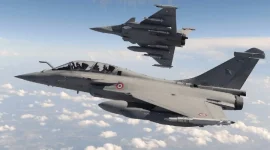- Views: 2K
- Replies: 10
Recent detailed photographs of China's J-20 stealth fighter jet have ignited intense debate online, particularly on the social media platform X (formerly Twitter). The images, showing features like exposed rivets and panel lines, have prompted discussions among aviation enthusiasts and military analysts worldwide regarding the aircraft's true stealth characteristics and design pedigree.
The close-up shots quickly went viral, fueling a war of words where users scrutinized the jet's surface details. Comparisons were frequently drawn between the J-20 and established stealth aircraft such as the American F-22 Raptor and F-35 Lightning II, as well as Russia's Su-57 Felon. The visible imperfections led many Western observers to question the effectiveness of the J-20's radar-evading design.
One widely shared post on X highlighted specific concerns, listing "Exposed rivets, Canards, Dogshit exhaust, Mid engines, Exposed panel seams, Reflective bodywork" as potential shortcomings. The user sarcastically commented, "Yep… Stealth mode on… Time to end the US global hegemony," suggesting the J-20's design might not meet the stringent requirements for a truly low-observable, fifth-generation fighter.
Developed by the Chengdu Aerospace Corporation, the J-20 represents a major component of China's military advancement program. It is positioned by Beijing as a direct competitor to leading American stealth fighters. Chinese official sources often emphasize its low radar cross-section, attributed to advanced composite materials and sophisticated aerodynamic shaping. However, the newly circulated images showing visible surface fasteners and gaps have led critics to argue these could potentially reflect radar signals, compromising its stealth profile.
Many Western commentators pointed out that the seemingly less refined finish, particularly the exposed rivets, contrasts with the smoother, more integrated surfaces typical of aircraft like the F-22. Some suggested these features indicate potential deficiencies in manufacturing or design sophistication. The debate also touched upon the J-20's origins, with some speculating about the extent to which its design might rely on acquired technology rather than purely indigenous development.
In defence of the J-20, supporters offered alternative explanations. One prominent theory suggests the visible rivets and seams might be deliberately designed to be covered or filled before operational missions. An observer on X noted the specific design of the fastener heads and surrounding countersinks, speculating, "I suspect they have plugs or putty they can attach prior to a mission." This hypothesis draws a parallel with the early US F-117 Nighthawk stealth attack aircraft, which reportedly used radar-absorbent putty to smooth surfaces and cover fasteners for missions. If applicable to the J-20, this preparatory step could significantly enhance its stealth characteristics when operationally deployed.
The discussion extended beyond surface details to other design elements. Critics argue that features like the J-20's canards (small forward wings), which are absent on US stealth fighters like the F-22 and F-35, could increase its radar signature. The engine exhaust design has also faced criticism for potentially lacking advanced heat-signature reduction features. Conversely, proponents argue these design choices might reflect different priorities, potentially favouring enhanced maneuverability or specific operational roles over maximizing stealth from all angles.
This technical debate carries significant geopolitical undertones. For some observers, particularly in China, the J-20 is a symbol of the nation's growing military capability and its challenge to perceived US dominance in military aviation. Others, mainly in the West, view the aircraft with skepticism, suggesting its capabilities might be overstated.
As the images continue to fuel discussion, the true extent of the J-20's stealth capabilities remains a subject of speculation and analysis. Without operational combat data or more detailed disclosures, determining whether its visible surface features represent a significant vulnerability or are mitigated through operational procedures is difficult. For now, the debate over the J-20's design continues largely in the public sphere, reflecting broader technological competition and national narratives.


